Young Bacchus

The sculpture depicts a young Bacchus, the mythological Greek god of wine, sculpted out of a luminous white marble and standing in a wine barrel amongst grapes and vines. Bartolini has cleverly utilised the classical contrapposto pose, characterised by a single weight-bearing leg, a bent knee and tilted hips, as a mode to complement Bacchus’ mythology; in this sculpture, he is depicted to be making wine in the traditional manner by stamping on the grapes with bare feet so to release their juice ready for fermentation. To recompense for the heavy left-leaning weight load created by the style, Bartolini incorporates a single tree stump which itself is covered with grapes and vine leaves to disguise its primary structural function and complement the sculpture from an artistic perspective. Bacchus’ right hand rests lightly on it as he gazes over his left shoulder and arm, which is placed on his weight-bearing hip; Bartolini has captured a moment of rest from manual labour for the young Bacchus.
Lorenzo Bartolini (1777-1850) was born at Savignano near Prato; he came from a peasant family and was apprenticed at the Pisani marble works in Florence. His first sculpting experience came as an alabaster carver in a factory in 1795, where he copied the engravings of John Flaxman (1755-1826). Enthused by the romance of Napoleon Bonaparte’s cause, he joined his army and became a drummer. Arriving in Paris in 1797, he joined the studio of the painter Jean-Baptiste Frédéric Desmarais, and later worked in the studio of the painter Jacques-Louis David (1748-1825); he also befriended Jean-Auguste-Dominique Ingres (1780-1867) during the revolutionary period.
Bartolini was a contemporary of Antonio Canova (1757-1822) and is considered one of the most important Italian sculptors of his time. In 1803 he won the Academy’s second prize with bas-relief depicting Kleobis and Biton, leading to the Prix de Rome in 1806. He was appointed director of the Carrara Sculpture Academy in 1807 and the official sculptor of the Imperial family by Napoleon I and his sister Elisa Baciocchi Bonaparte. After the fall of the Emperor in 1815, Bartolini returned to Florence and decided to abandon his classical style in favor of the neo-renaissance style, which was very much in vogue in Italy at the time.
Young Bacchus or Il Vendemmiatore, was originally commissioned by the French Collector, Count Pourtales in 1818, although the generally accepted date for the work is 1820. The gesso model for the work remained in the artist’s studio and is now in the Gipsoteca Bartoliniana in Florence. The model was repeated twice with small variations for Count Paolo Tosi of Brescia and the Marchese Buffalini in Florence. The former model (1844) was given by the owners family to the Pinacoteca Tosi-Martinengo at Brescia, the latter is the present work.



